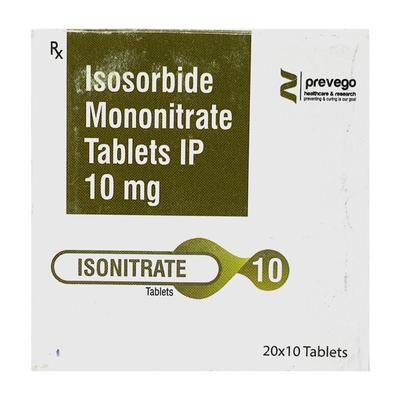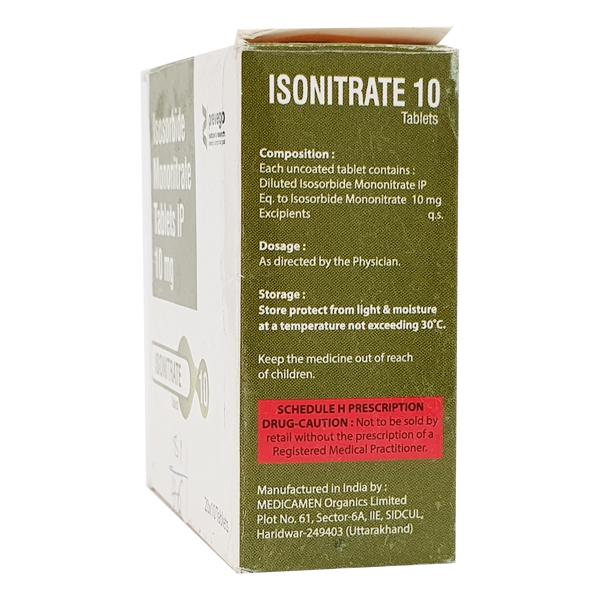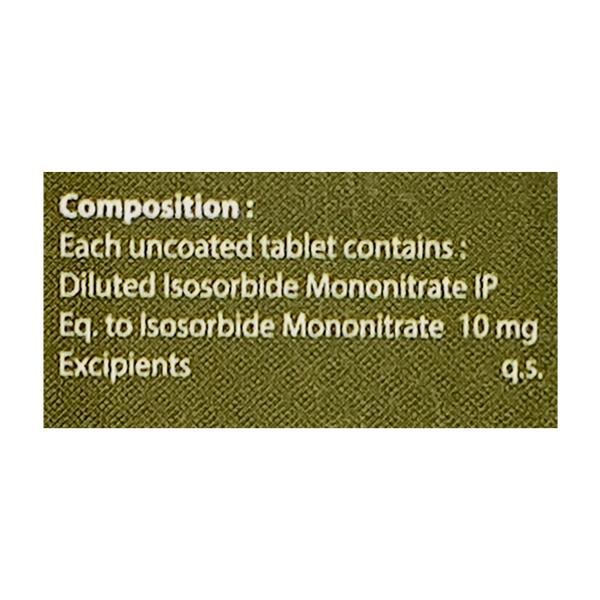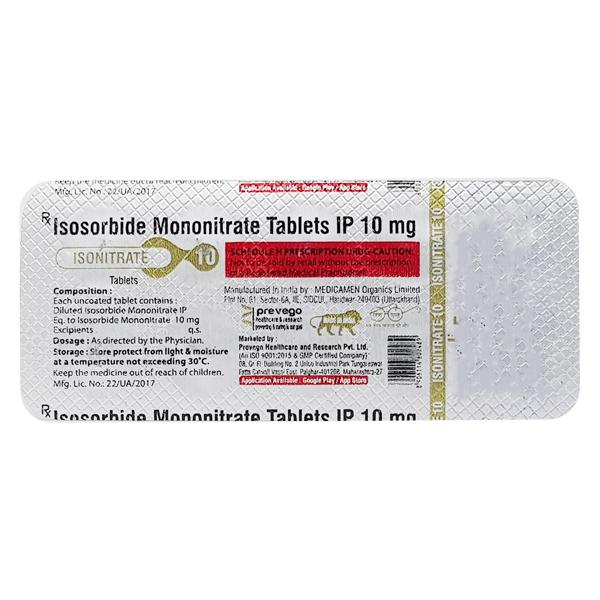

Netmeds First Membership
Quick Links
Introduction About ISONITRATE 10 TABLET
ISONITRATE 10 TABLET contains Isosorbide Mononitrate which belongs to the group of medicines called Nitrate vasodilators. It is used to manage angina pectoris and heart failure (when your heart cannot pump enough blood around the body). Angina pectoris is a type of chest pain caused when your heart muscle does not get enough blood supply. The pain is severe and crushing and it is characterized by a feeling of pressure and suffocation, behind the breastbone.
Your doctor may advise you to follow lifestyle changes such as diet changes (taking foods low in fat, salt or sugar) and do regular mild exercises to achieve better results during management with this medicine.
ISONITRATE 10 TABLET is not recommended for use in patients with heart problems such as circulatory collapse, cardiogenic shock, hypertrophic obstructive cardiomyopathy (a thickened heart muscle), cardiac tamponade (accumulation of fluid around the heart), severe anemia (low-level of red blood cells) and severe hypovolemia (decreased blood volume).
Before taking ISONITRATE 10 TABLET, inform your doctor if you have a history of liver or kidney problems, hypothyroidism and low body temperature (hypothermia). ISONITRATE 10 TABLET should be used with caution in pregnant and breastfeeding women, so consult your doctor before taking it.
It is not recommended for use in children and should be used with caution in elderly patients. The common side effects of taking ISONITRATE 10 TABLET are headache, nausea, vomiting and low blood pressure. Consult your doctor if any of the side effects worsen.
Uses Of ISONITRATE 10 TABLET
- Manages Angina Pectoris (chest pain) and heart failure
How ISONITRATE 10 TABLET Works
ISONITRATE 10 TABLET helps to relax the blood vessels and muscles of the heart, which causes the space inside the blood vessels to widen. This helps to ease the flow of blood in the blood vessels of the heart and provides relief from the pain associated with the blockage of vessels as seen in angina.
How to use ISONITRATE 10 TABLET
Take ISONITRATE 10 TABLET as advised by your physician. Swallow the medicine with a glass of water. Do not crush or chew the medicine. Your doctor will decide the correct dose and duration of ISONITRATE 10 TABLET for you depending on your age, body weight and disease condition.
Side Effects Of ISONITRATE 10 TABLET
Common
- headache
- nausea, vomiting
- decreased blood pressure (hypotension)
- drop in blood pressure when standing up or moving suddenly (postural hypotension). accompanied by a fast heartbeat, dizziness or feeling weak
Uncommon
- skin flushing
- drop in blood pressure may lead to an increase in chest pain (exacerbation of angina pectoris symptoms)
- collapse state (sometimes with slowing of the heartbeat and fainting)
Rare
Stop taking ISONITRATE 10 TABLET and consult your doctor immediately if you experience any of the following side effects:
- chest pain or experiencing worsening of chest pain
How To Manage Side Effects
Headache
Drink ample amount of water and avoid skipping meals. Get adequate rest. Try to be relaxed and stress free. Apply pain relieving balm on your forehead if necessary. Consult your doctor if the symptom does not improve.
Nausea And Vomiting
Take ISONITRATE 10 TABLET with or just after meals. Stick to simple meals. Avoid eating oily, fried or spicy foods. Do not lie down or sleep immediately after eating. Consult your doctor if the symptom does not improve.
Warning & Precautions
Pregnancy
Monitoring requiredISONITRATE 10 TABLET should be used with caution in pregnant women and those who are planning for pregnancy unless considered clearly necessary. Consult your doctor before taking ISONITRATE 10 TABLET.
Breastfeeding
Monitoring requiredISONITRATE 10 TABLET should be used with caution in breastfeeding women unless considered clearly necessary. Consult your doctor before taking ISONITRATE 10 TABLET.
Driving and Using Machines
Use with CautionDo not drive or operate any machines if you experience blurred vision, dizziness or light-headedness after standing up or moving suddenly after taking ISONITRATE 10 TABLET.
Alcohol
Consult your doctorAvoid consumption of alcohol while taking ISONITRATE 10 TABLET because it might increase the risk of dizziness and fainting due to a reduction in blood pressure.
Kidney
Use with CautionISONITRATE 10 TABLET should be used with caution in patients with severe problems in the kidney. Consult your doctor before taking ISONITRATE 10 TABLET.
Liver
Use with CautionISONITRATE 10 TABLET should be used with caution in patients with severe problems in the liver. Consult your doctor before taking ISONITRATE 10 TABLET.
Allergy
ContraindicatedDo not take ISONITRATE 10 TABLET if you are allergic to isosorbide mononitrate or other nitrates (such as isosorbide dinitrate)
Heart Disease
Consult your doctorISONITRATE 10 TABLET is not recommended for use in patients with circulatory collapse or shock, cardiogenic shock, acute myocardial infarction with low left ventricular filling pressure, hypertrophic obstructive cardiomyopathy (a thickened heart muscle), constrictive pericarditis (an inflammation of the heart sac), cardiac tamponade (accumulation of fluid around the heart) and aortic/mitral valve stenosis (narrowing of heart valves). It should be used with caution in patients with a recent history of myocardial infarction (heart attack). Consult your doctor before taking ISONITRATE 10 TABLET.
Use In Pediatrics
ContraindicatedISONITRATE 10 TABLET is not recommended for use in children due to lack of safety and effectiveness. Consult your child’s doctor for advice.
Use In Geriatrics
Use with CautionISONITRATE 10 TABLET should be used with caution in elderly patients. Consult your doctor before taking it.
Others
ISONITRATE 10 TABLET is not recommended for use if you have:
- marked low blood pressure (systolic blood pressure ≤ 90 mmHg)
- severe anemia (low level of red blood cells)
- closed angle glaucoma (high pressure in the eye)
- conditions associated with raised pressure on the brain (following head trauma and cerebral haemorrhage)
- severe hypovolemia (decreased blood volume)
Before taking ISONITRATE 10 TABLET, inform your doctor if you:
- have hypothyroidism
- suffer from malnutrition
- have low body temperature (hypothermia)
Interactions
A. Drug-Drug Interactions
Before taking ISONITRATE 10 TABLET, inform your doctor if you are taking any of the following medicines:
- medicines used to manage male impotency (Ex. sildenafil, tadalafil, alprostadil)
- medicines used to manage high blood pressure such as calcium channel blockers (Ex. verapamil), angiotensin-converting enzyme (ACE) inhibitors (Ex. captopril, lisinopril), angiotensin II receptor blockers (Ex. azilsartan, candesartan), beta-blockers (Ex, metoprolol, atenolol) and diuretics (Ex. hydrochlorothiazide)
- aldesleukin (used for cancer management)
- sapropterin (used to lower phenylalanine levels in the blood of patients with phenylketonuria)
- neuroleptics (Ex. haloperidol, trifluoperazine) (used to manage psychiatric disorders)
Overdosage:
If you or anyone else accidentally take too much of ISONITRATE 10 TABLET, consult your doctor immediately or visit the nearby hospital. Symptoms of overdosage are nausea, vomiting, restlessness, warm flushed skin, blurred vision, headache, fainting, fast heartbeat, low blood pressure, palpitations, bluish discolouration of the skin and mucous membranes due to reduced oxygen content of the blood, shortness of breath, rapid shallow breathing (tachypnoea) and increased pressure within the skull (intracranial pressure) may occur.
Synopsis
| Drug | : | Isosorbide mononitrate |
| Pharmacological Category | : | Nitrate vasodilators |
| Therapeutic Indication | : | Angina, Heart failure |
| Dosage Forms | : | Tablet, Capsule |
More Information
Storage
- Keep ISONITRATE 10 TABLET out of reach of children.
- Store at room temperature
FAQs About ISONITRATE 10 TABLET
Q: What is ISONITRATE 10 TABLET used for?
A: ISONITRATE 10 TABLET is used to manage angina pectoris and heart failure (when your heart cannot pump enough blood around the body). Angina pectoris is a type of chest pain caused when your heart muscle does not get enough blood supply. The pain is severe and crushing and it is characterized by a feeling of pressure and suffocation, behind the breastbone.
Q: Can ISONITRATE 10 TABLET be used in elderly patients?
A: Yes, ISONITRATE 10 TABLET should be used with caution in elderly patients. Your doctor may adjust the dose of ISONITRATE 10 TABLET due to the increased risk of side effects in elderly individuals. Consult your doctor before taking it.
Q: Is ISONITRATE 10 TABLET safe to use during pregnancy?
A: ISONITRATE 10 TABLET should be used with caution in pregnant women and who are planning for pregnancy unless considered clearly necessary. Consult your doctor before taking ISONITRATE 10 TABLET if you are pregnant or planning to get pregnant.
Q: What are the common side effects of ISONITRATE 10 TABLET?
A: The common side effects of taking ISONITRATE 10 TABLET are headache, nausea, vomiting and low blood pressure. Consult your doctor if any of the side effects worsen.
Q: Can I drive or operate machines after taking ISONITRATE 10 TABLET?
A: Do not drive or operate any machines if you experience blurred vision, dizziness or light-headedness after standing up or moving suddenly. Consult your doctor before taking this medicine.
References
1. KD. Tripathi. Antianginal and Other Anti-ischaemic Drugs. Essentials of Medical Pharmacology. Seventh edition. 2013. Page 539-588
2. Gunasekara, N.S. and Noble, S. Isosorbide 5-Mononitrate, Drugs. [Revised in October 2012] [Accessed on 20th July 2022] https://link.springer.com/article/10.2165/00003495-199957020-00016
3. Walker, J.M., Curry, P.V.L., Bailey, A.E. and Steare, S.E. A comparison of nifedipine once daily (Adalat LA), isosorbide mononitrate once daily and isosorbide dinitrate twice daily in patients with chronic stable angina. International journal of cardiology. [Accessed on 20th July 2022] https://www.sciencedirect.com/science/article/abs/pii/0167527395025316
4. Kern Pharma S.L. Electronic Medicines Compendium (EMC). [Revised in December 2021] [Accessed on 20th July 2022] https://www.medicines.org.uk/emc/files/pil.13637.pdf
Useful Diagnostic Tests
- Electrocardiogram (ECG)
- Chest x-ray
- Chest CT
- Echocardiogram












